Andorra Travel Guide
Welcome to the taste2travel Andorra Travel Guide!
Date Visited: May 2018
Introduction
During my many years of living in Europe, I had the opportunity to explore most parts of the continent, however, there was one small stone which always remained un-turned, a country I’d passed many times without setting foot in – the Principality of Andorra. And so, on a recent trip to Europe, I took the opportunity to make the pilgrimage up into the Pyrenees mountains to explore this tiny alpine jewel, the world’s only predominately Catalan-speaking nation.

The flag of Andorra, a vertical tri-colour of blue, yellow, and red with the coat of arms of Andorra in the centre.
According to the constitution, Andorra is a Principality that retains the President of France and the Bishop of Urgell (Spain) as co-princes and heads of state.

The backbone of Andorra, the Pyrenees mountain range separates the Iberian Peninsula from the rest of Europe.
Located off the standard tourist trail, high in the southern Pyrenees mountains, wedged between two neighbouring giants (France and Spain), Andorra is a small country in terms of area and population (77,281) and one which is often overlooked on travel itineraries.

The white ski slopes of the Vallnord resort cut a clear path across the mountain.
Those travelers who do make the journey are rewarded with spectacular hiking trails, superb skiing, gourmet food, duty free shopping and time spent in picturesque towns and villages surrounded by towering, majestic peaks. Andorra is a stunningly beautiful, fascinating destination – one that should not be missed.
Location
Andorra is a landlocked Principality, located high up in the southern peaks of the Pyrenees Mountains, bounded by France to the north and east and by Spain to the south and west. With a total land area of 468 km2 (181 sq mi), Andorra is the sixth-smallest nation in Europe. The country consists predominantly of rugged mountains and has an average elevation of 1,996 metres (6,549 ft).

The towering Pyrenees mountain range, Andorra.
History

Originally built as a manor house, the 16th century “Casa de la Vall” previously housed the General Council (Parliament of Andorra).
In historical terms, Andorra as a country is a relic from a by-gone era when Europe was divided up into thousands of small sovereign nations – each no bigger than an average modern city. Over the centuries, this patchwork of micro-nations was unified into the larger nations which exist today.
Andorra, in its current form, has existed for more than a thousand years, with its independence accredited to the French King – Charlemagne – who took control of the country from Muslim invaders in AD 803. His son, Louis the Pious (aka Louis the Fair, and Louis the Debonaire), gave the Andorran’s a charter of liberties. In AD 843, Louis’ son, Charles II, gave control of Andorra to the Counts of Urgell (from nearby La Seu d’Urgell – now in Spain). The Counts passed control of Andorra to the Bishops of Urgell.
In the late 13th century a quarrel between the Spanish Bishops of Urgell and the French heirs to the Countship of Urgell led to Andorra’s dual allegiance to two princes – the Spanish Bishop of Urgell and the French head of state, each of whom received an annual payment of a token tribute.
Andorra Today

The New General Council – the parliament of Andorra.
This feudal system of government remained intact until March of 1993, when Andorrans voted to establish a new constitution that officially declared the country a “parliamentary co-principality“. A constitution was adopted that greatly reduced the power of the co-princes and established separate executive, legislative, and judicial branches of government. Andorra subsequently joined the United Nations in 1993.
Today, tourism is the main economic activity of the country with financial services also playing an important role. Andorra has the status of a ‘tax haven’ and, like Switzerland, has its own banking secrecy laws.

The busy land border between Spain and Andorra.
Because of the lack of customs duties and low or nonexistent taxes, Andorra has become an important international centre of retail trade and is a popular duty-free shopping destination for French and Spanish day-trippers. Due to its ‘duty free shopping paradise’ reputation, Spanish customs officials normally perform thorough searches on anyone entering Spain from Andorra.
Currency and Costs

Andorra Euro coins. Image Source: fleur-de-coin.com
Currency
An interesting fact: Prior to 2002, Andorra never had its own official currency. Historically it used the French franc and Spanish peseta but when they were replaced in 2002 by the Euro (€), Andorra adopted that currency.
While Andorra is not a member of the European Union, it has an agreement with the EU to use the Euro (€) as its official currency, and to mint it’s own Euro coins.
Costs
Due to its duty-free status, travelling in Andorra is reasonably cheap (for Europe)! My comfortable room at the decent (mid-range) Hotel Festa Brava cost me €54 per night, while breakfast in a nearby cafe cost me less than €10. Car rental through Goldcar cost me €22 per day (on a multiple day rental) while a main course in a restaurant (with a glass of wine) can cost as little as €10.
A reasonable daily budget allowance for Andorra would be:
- Budget: €80
- Mid-range: €80-175
- Top-end: €175+
Sights
Andorra La Vella

A centre-piece of the old town, Sant Esteve church was built in the 11th-12th century.
Perched high in the eastern Pyrenees at an elevation of 1,023 metres (3,356 feet) above sea level, Andorra La Vella has the distinction of being the highest capital city in Europe. With a population of 22,000, the capital has the feel of a large, relaxed town and is compact enough to explore on foot in one day, with most of the sights concentrated in the old town and most of the shops in the adjacent new town.
Old Town
Sights within the old town include the historic Casa de la Vall, which was built in 1580 as a manor house for a rich family but was later converted for use by the General Council (Parliament of Andorra). In 2011, parliament relocated to the modern (adjacent) General Council building and the Casa was converted into a museum.

“Transparency” by Spanish artist Samantha Bosque.
On the wall of a nearby building is the Trompe l’oeil masterpiece “Transparency“, which was painted by the Spanish artist Samantha Bosque. The painting is an exact facsimile of the square which is located behind the building – hence the title. If you get the angle correct, you can perfectly align the left side of the painting with the top of the mountain in the background.
New Town

“7 Poetes” by Jaume Plensa.
Just below the new parliament building, in Plaça Lidia Armengol Vila is “7 Poetes“, a striking art installation by the Spanish artist Jaume Plensa. The seated seven figures (which are illuminated at night) represent the seven parishes that form Andorra and aim to offer an air of calm and reflection amid the hustle and bustle of the city.

“La Noblesse du Temps” by Salvador Dalí.
How many cities in the world can claim to have their own Salvador Dalí sculpture sitting on the sidewalk? Located in the new part of town, in Placa de la Rotonda (on the banks of the raging Valira river), is La Noblesse du Temps, a 16 foot bronze clock which has been created using Dalí’s unmistakable sinewy, surreal style. The sculpture symbolises the passage of time and features an elongated clock face on a tree trunk, topped by a crown. Ironically, the Cartier watch shop is located in close proximity.

The “Pont de Paris” in downtown Andorra La Vella.
A short walk from Dalí’s surreal installation is the much more sober Pont de Paris, a cable bridge which crosses the (always raging) Gran Valira River.
Outside Andorra La Vella

The majestic Pyrenees Mountain Range, Andorra
The one excellent highway in Andorra takes you from the Spanish border to the French border in under an hour, passing through the urban centres of Sant Julia de Loria, Andorra La Vella, Encamp, Canillo then onto the French border town of Pas de la Casa.

A view of the picturesque Vall d’Incles.
While the drive is scenic (especially towards the French border), it’s the many side roads which lead off the highway, that offer the most spectacular scenery.
Western Andorra

A display of opulent cigarette boxes at the Museu del Tabak in Sant Julià de Lòria.
If you’re arriving from Spain, your introduction to Andorra will be the pleasant town of Sant Julia de Loria (elev: 935 m), which offers plenty of tourist services such as accommodation, restaurants and a beautiful old town.

Am antique cigarette-making machine at the Museu del Tabac.
In the heart of the old town is the engaging Museu del Tabac, which is housed in an old tobacco factory and tells the story of the local tobacco industry.

A display at the Museu del Tabac.
Prior to tourism and financial services, tobacco was an important industry for Andorra, with cigarettes being sold (and smuggled) into France and Spain.

The magnificent scenery on route CS-140 as I wind my way up to the “Coll de la Gallina” mountain pass.
South of Sant Julia de Loria a scenic side road, CS-140, winds 12 km up into the high heavens, climbing 975 metres to the mountain pass of Coll de la Gallina (elev: 1,910 m), which forms the border between Andorra and Spain. This route features steep gradients and forms stage 9 of the Tour de France and is the most popular form of punishment for visiting cyclists and Tour de France wannabe’s.

Route CS-142, a narrow, steep, one-lane and sometimes icy road which climbs up to the “Coll de la Gallina”.
As you climb, the CS-140 becomes the CS-142, at which point the road becomes very narrow, one-way, with steep drop-offs and no guard rails. This is not a route for less-confident drivers and on the day I drove it, there was the added challenge presented by patches of black, slippery ice.

“Road Closed Ahead”. The road on the Spanish side of the “Coll de la Gallina” was impassable.
To top it off, once I reached the pass, the road on the Spanish side was impassable, laying buried beneath metres of snow and ice. My only option was to do a U-turn and proceed back down the mountain, travelling the wrong way on the narrow, one way road. Luckily, I was the only fool on the road so I didn’t encounter any oncoming traffic.

The River Os cascades down a narrow gorge alongside route CG6.
Just north of Sant Julia de Loria, route CG6 follows the course of the narrow river – Rui d’Os – which roars down from higher elevations through a tight, winding gorge. The road connects the main highway to the Spanish border (immediately noticeable due to the sudden deterioration in road quality) then continues onto the sleepy Spanish town of Os de Civis. An interesting fact regarding ‘Os’ is that it is cut-off from the rest of Spain and is only accessible through Andorra along this route.

Pyrenees Mountain Range, Andorra.
While on route CG6, you’ll pass through the village of Bixessarri, where you have the option of taking two narrow, winding roads which switch-back their way up either side of the valley formed by the River Os.

The tiny chapel of Sant Joan d’Aixàs sits atop a ridge which offers panoramic views in all directions.
Route CS-112 climbs up to a ridge which is topped with a small chapel, Sant Joan d’Aixàs, from which you have magnificent views of all of southern Andorra. Climbing up even higher on the other side of the valley, route CS-111 is an alternative route to the pass at Coll de la Gallina.

The very narrow (but two way) route CS-112.
Northern Andorra

The picturesque village of Ordino.
From Andorra La Vella route CG3 follows a gentle valley north to the junction town of La Massana, before branching off to the historic town of Ordino. The town was first mentioned in documents in the 9th century and is today considered the cultural centre of Andorra.

Andorran drivers are adept at driving at speed through tight lane ways such as this one in Ordino.
The old town was constructed during the 12-13th centuries with narrow, cobbled, pedestrian-friendly streets. Andorrans are use to driving in tight spaces so it was no surprise to see drivers zipping through the narrow lane-ways.

The narrow lane ways of Ordino village.
Ordino is a popular base for people skiing in the Vallnord region and offers an abundance of accommodation and restaurant options.

The Església de Sant Martí de la Cortinada was originally built in the 11th century.
Continuing along CG3 north of Ordino, you’ll soon reach the village of La Cortinada, whose main claim is the beautiful Església de Sant Martí de la Cortinada, a stone church which was originally built in the 11th-12th century and later rebuilt in the 17th century.

A panoramic view from the Arcalis ski resort (the road tunnel can be seen below).
Continuing up the valley, CG3 becomes CS-380 at which point the road commences a steep climb through numerous hair-pin turns then enters a tunnel before arriving at the chairlift station of the Vallnord Arcalis ski resort.
The Vallnord ski resort consists of three resorts which are (from north to south):
- Arcalis
- Arinsal
- Pal
Arinsal and Pal are linked by chairlift while Arcalis is a separate resort.

The historic village of Pal.
Back at the junction town of La Massana, route CG4 provides access to the linked ski resorts of Arinsal and Pal. En-route to the Pal resort, the road passes through the quaint and historic village of the same name. With oodles of charm and a population of just 235 souls, Pal is worth exploring before you start the climb up the mountain to the Pal ski resort.

“No Through Road” – the road on the Spanish side of Port de Cabús was impassable.
Just when you think the road couldn’t possibly climb any higher, CG4 keeps climbing up to the mountain pass of Port de Cabús (elev: 2302 m) which marks the border with Spain. An (un-maintained) road continues into Spain but during my visit it was completely impassable due to a thick covering of snow and ice.

A novel way of walking the dogs at the Pal ski resort.
In the village of Erts, CG5 branches off of CG4, providing access to the lofty Arinsal ski resort. This is yet another spectacular alpine drive offering more incredible views. The windy road climbs through numerous hair-pin turns before terminating at the Arinsal resort (elev: 1900 m).

More incredible views – this time from the Arinsal ski resort.
Eastern Andorra

Majestic peaks line route CG2 near the French border.
The highway east of Andorra La Vella (CG2) passes through the busy towns of Encamp and Canillo then onto a junction where you have the choice of taking the scenic high road (yes please!) or the (subterranean) low road through a tunnel to the border town of Pas de la Casa. The views from the mountain pass on the high road are jaw-dropping and should not be missed. If you’re in a rush, the tunnel is much faster but far less scenic.

“A window onto the world” – a view from route CG2 on the way to Pas de la Casa.
Despite its location in a stunningly beautiful valley, surrounded on all sides by towering peaks, Pas de la Casa is essentially one large duty-free shopping centre for French day-tripper’s. The border is formed by the narrow Ariège river which flows through the town centre. Giant petrol stations on the outskirts of town are always busy with French motorists who cross to fill up at prices far below those in France.

A stone bridge crosses the River Incles in the pretty Vall d’Incles.
A worthwhile side trip in this part of Andorra is along the narrow country lane which follows the River Incles (Riu d’Incles) into the picturesque Vall d’Incles. The turn-off from the highway is between the villages of El Tartar and Soldeu after which you drive on a one lane (but two way) road into the charming valley.

The picture-postcard perfect Vall d’Incles.
Accommodation
With more than 300 properties, Andorra offers an abundance of accommodation options from cheap hostels to 5-star hotels. Accommodation can be found throughout the country but is concentrated in the capital. A good place to start your search is the accommodation directory on the Visit Andorra website.
While in Andorra la Vella, I stayed at the mid-range Hotel Festa Brava, which offers reasonably priced (€54 per night), comfortable rooms in the heart of the old town. From the hotel it’s a very short walk to the restaurants, cafes and bars of the old town, the main shopping street and most tourist attractions. As with everywhere else in the capital, car parking spaces are non-existent but the hotel has an arrangement with the parking garage at the nearby Centre Comercial Pyrénées, which allows guests to park overnight at a 50% discount.
Eating Out

Artwork at the Papanico restaurant.
Andorra is home to about 400 restaurants, and being surrounded by France and Spain – two of the world’s foremost gourmet destinations – there’s no shortage of fine cuisine on offer, especially in the capital. Eating fine quality food in Andorra does not mean emptying your wallet with humble cafes serving delicious ‘fixed menu’ three-course meals for less than €15. The Eating page on the Visit Andorra website provides an overview of Andorran cuisine and a restaurant directory.
My go-to place for breakfast was the Cafeteria La Terrassa, which is located on the third floor of the Centre Comercial Pyrénées (shopping mall) in downtown Andorra la Vella. Open 7 days a week, the cafeteria offers sweet and savoury crepes, fine french pastries, freshly squeezed (Valencia) orange juice and wonderfully strong coffee.
My favourite bar in Andorra La Vella was the lively Hostal & Pub Barri Antic which is located opposite the Parliament building in the old town. The pub, which is a favourite haunt for anyone on a biking trip to Andorra, offers quaffable craft beers and wonderful cocktails which are always served with olives or freshly popped popcorn, while upstairs, the hostal offers very cheap (€25), tastefully decorated rooms. In the early evening, outdoor tables fill the narrow lane-way and are always abuzz with locals and tourists enjoying the ambience. From here, most restaurants are a short stroll, making this an ideal place to start your evening out in the old town!
For dinner in the old town, the very memorable Restaurant Versailles offers gourmet food, impeccable service and a very agreeable ambience. I arrived without a reservation and was seated immediately. The friendly owner then presented me with a glass of a Cuvée on the house and some olives, then provided a comprehensive explanation of the menu. I ordered steak, which was served with mashed potatoes and fresh, wild asparagus – it tasted divine!

Delicious, good value meals can be found in many restaurants such as the Restaurant La Casa del Boeuf.
Nearby, the Restaurant La Casa del Boeuf offers decent French cuisine which is prepared by the friendly French chef – Joel. Daily special menus allow diners to choose one of four main courses which are served with a glass of house wine for just €10.50! The ‘Steak-frites‘ with red wine is highly recommended and (at €10.50) a real bargain.
Visa Requirements
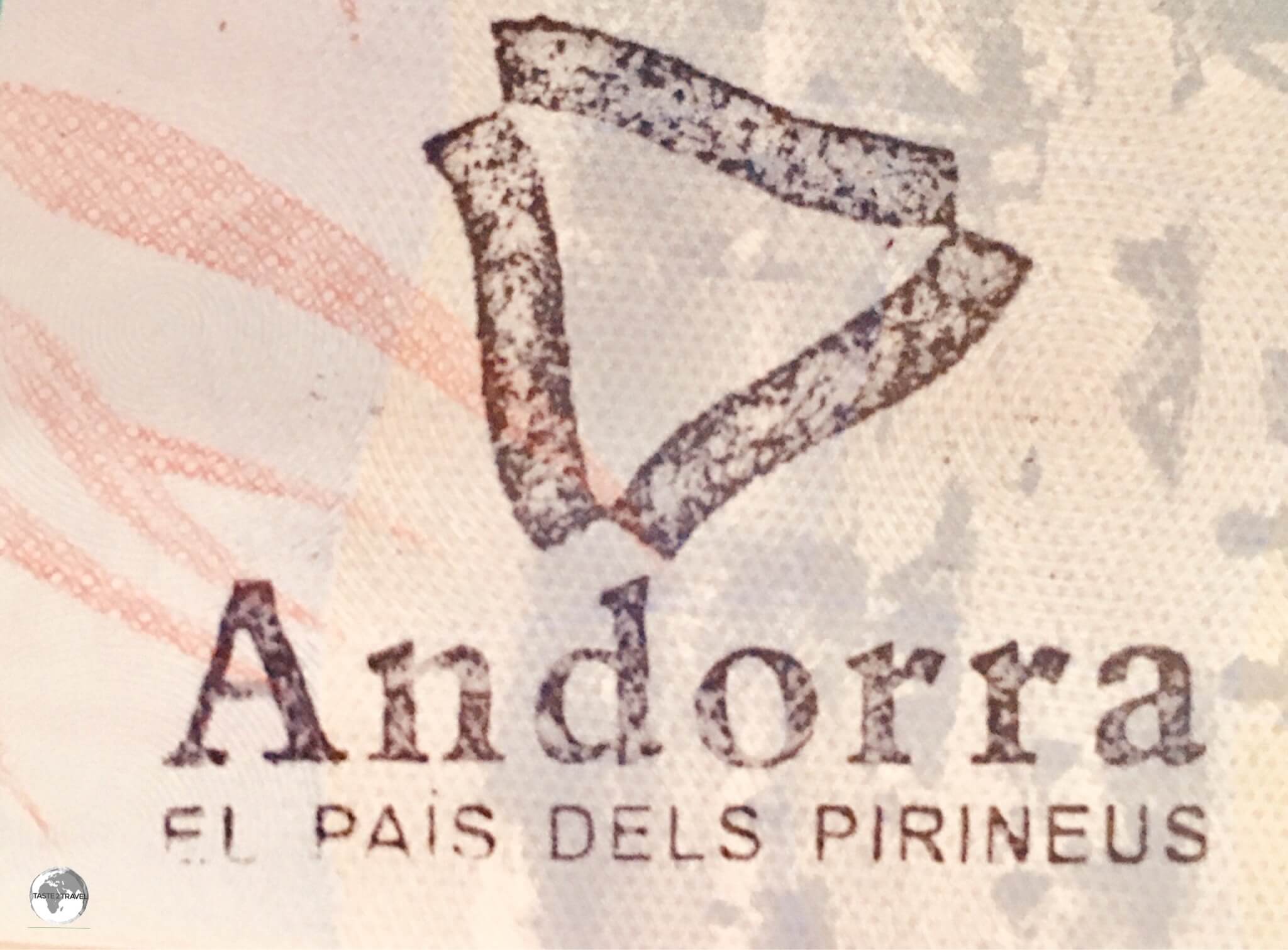
A souvenir passport stamp, ‘Estampa Turista’, is available from the immigration office at the border.
The visa policy of Andorra is wonderfully simple – every passport holder on this planet is free to enter without needing a visa! However, since the country is only accessible via the Schengen countries of Spain or France, entrance is not possible without entering the Schengen area first and the Schengen visa rules can therefore be regarded to apply de-facto.
If you are travelling on a passport which requires a Schengen visa, you should know that because Andorra is not part of the Schengen area, a multiple entry visa is required to re-enter the Schengen area when leaving Andorra.
Immigration Formalities
Upon entering Andorra, there are no immigration formalities. If you wish to obtain a souvenir passport stamp, you can do so at any of the border posts.
Getting There

An Andorra Welcome Sign.
Air
Because of its impossibly mountainous terrain, there is no airport in Andorra. The two de-facto airports serving the principality are Spain’s Barcelona Airport and France’s Toulouse airport. Regular daily bus connections operate between these gateways and the bus station in Andorra La Vella, a journey of approximately 3 hours from either city. For details on the buses please refer to the ‘Getting There – Bus‘ section below.
Road
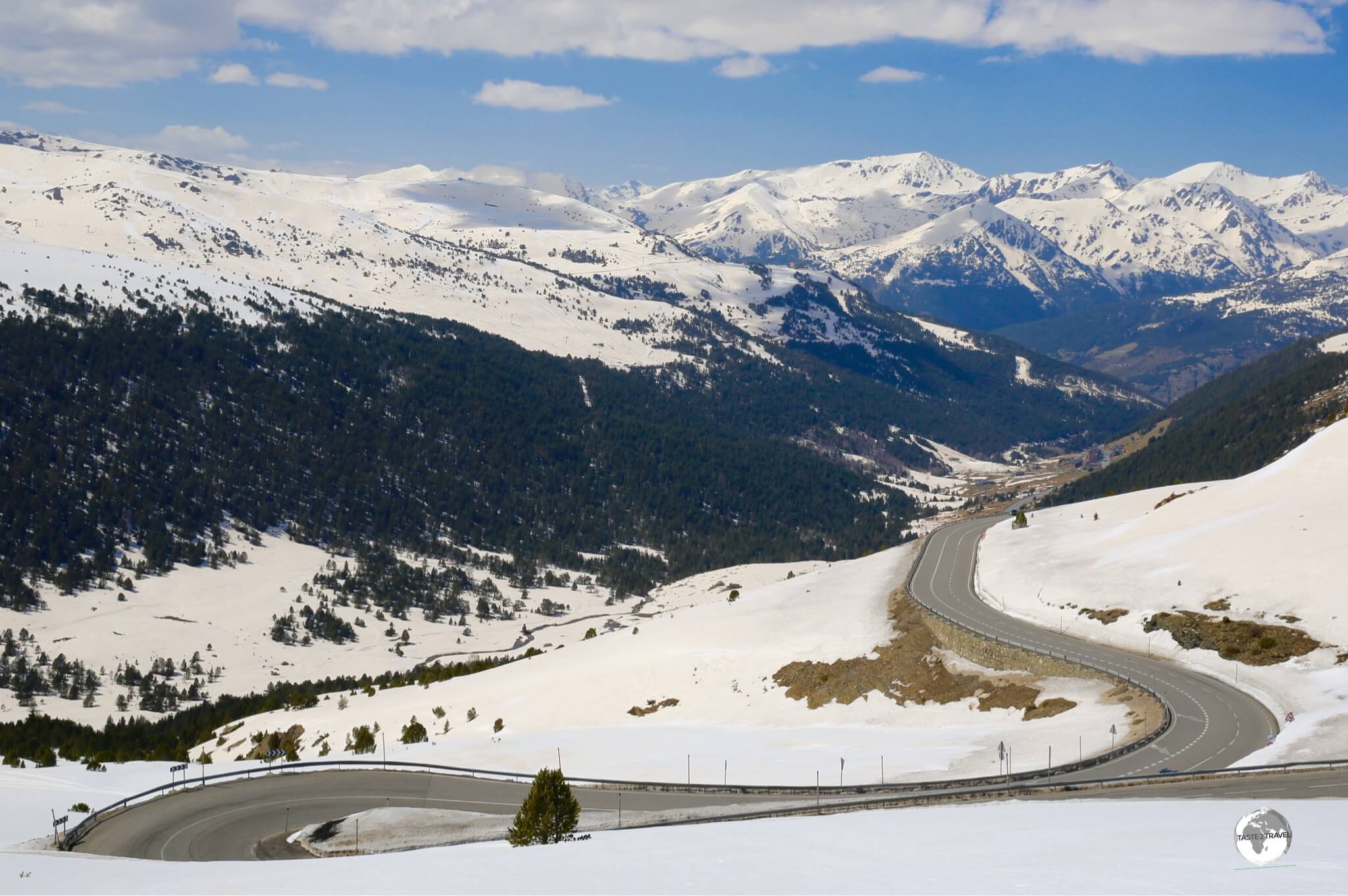
The only highway in Andorra cuts diagonally through the country from the Spanish to the French border.
Due mainly to the mountainous nature of Andorra, there is only one road entering the principality from France and only one (widely-used) road entering Andorra from Spain.
Almost all entry into the country happens at one of these two points which can be very congested when exiting Andorra as Spanish and French customs officials perform thorough checks on all the happy shoppers leaving the duty-free paradise that is Andorra.
Bus

The modern and efficient bus station in Andorra La Vella.
Comfortable coaches provide regular connections from Andorra to both Spain and France.Regular international buses connect Andorra to destinations in Spain and France. Following is a list of current operators (with links to online booking pages):
Spain
- Direct Bus: Offers 10 daily return services between Andorra and Barcelona Airport – with some services also stopping at Barcelona (Sants) bus station. Timetables, fares and bookings available here.
- ANDBUS (Andorra By Bus): Offers 7 daily return services between Andorra and Barcelona Airport. Timetables, fares and bookings available here.
- Montmantell Bus: Offers 14 daily return services between Andorra and the nearby Spanish town of La Seu d’Urgell. The current timetable can be viewed here.
- Montmantell Bus: Offers 6 daily return services between Andorra and the Spanish city of LLeida. The current timetable can be viewed here.
- Montmantell Bus: Offers 1 daily return service between Andorra and the Spanish coastal region of Costa Daurada (i.e. Tarragona). The current timetable can be viewed here.
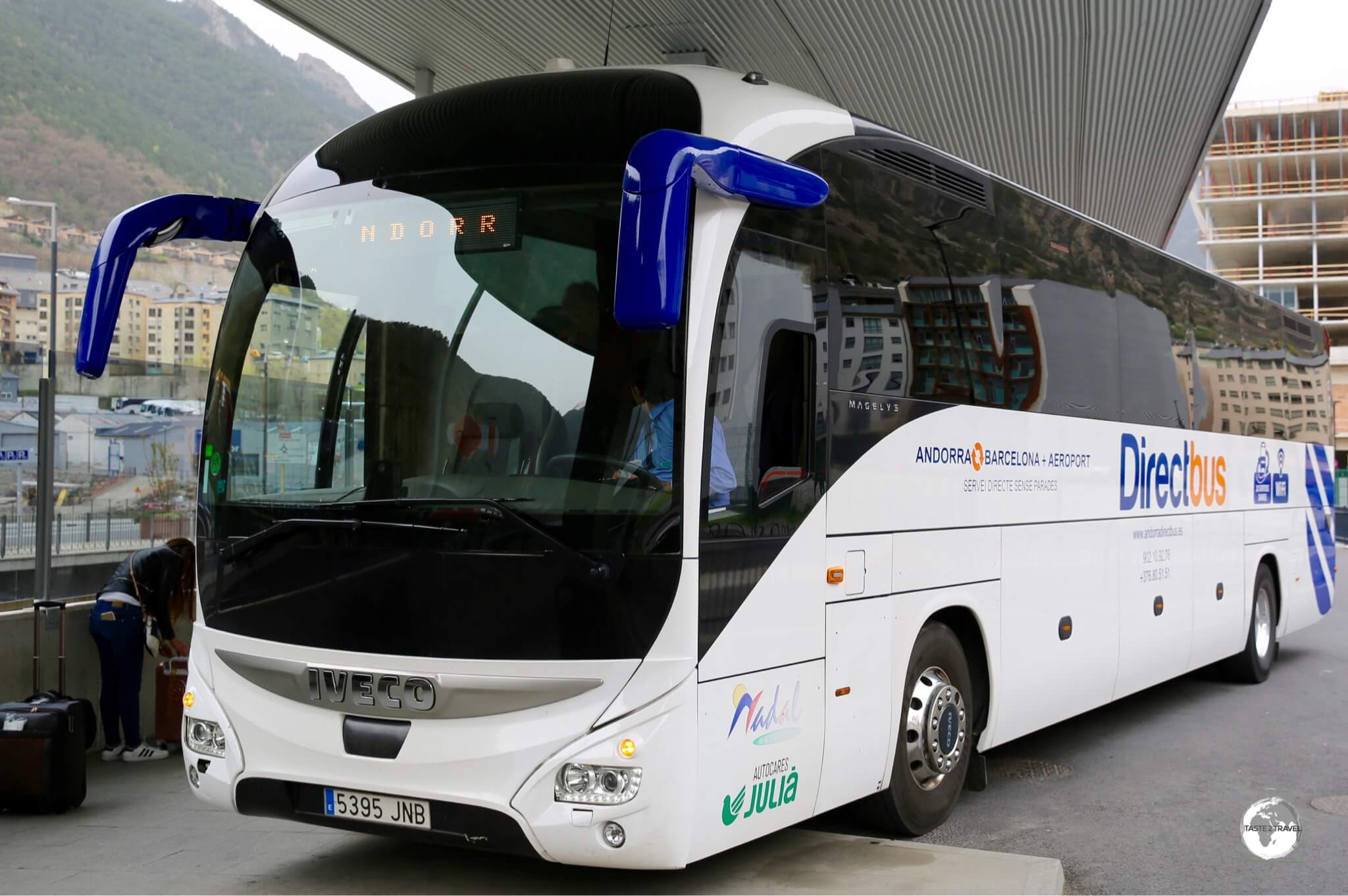
Comfortable coaches provide regular connections from Andorra to both Spain and France.
France
- ANDBUS (Andorra By Bus): Offers 3 daily return services between Andorra and Toulouse Airport. Timetables, fares and bookings available here.
- Montmantell Bus: Offers 2 daily return services between Andorra and the nearby French town of L’Hospitalet. The current timetable can be viewed here.
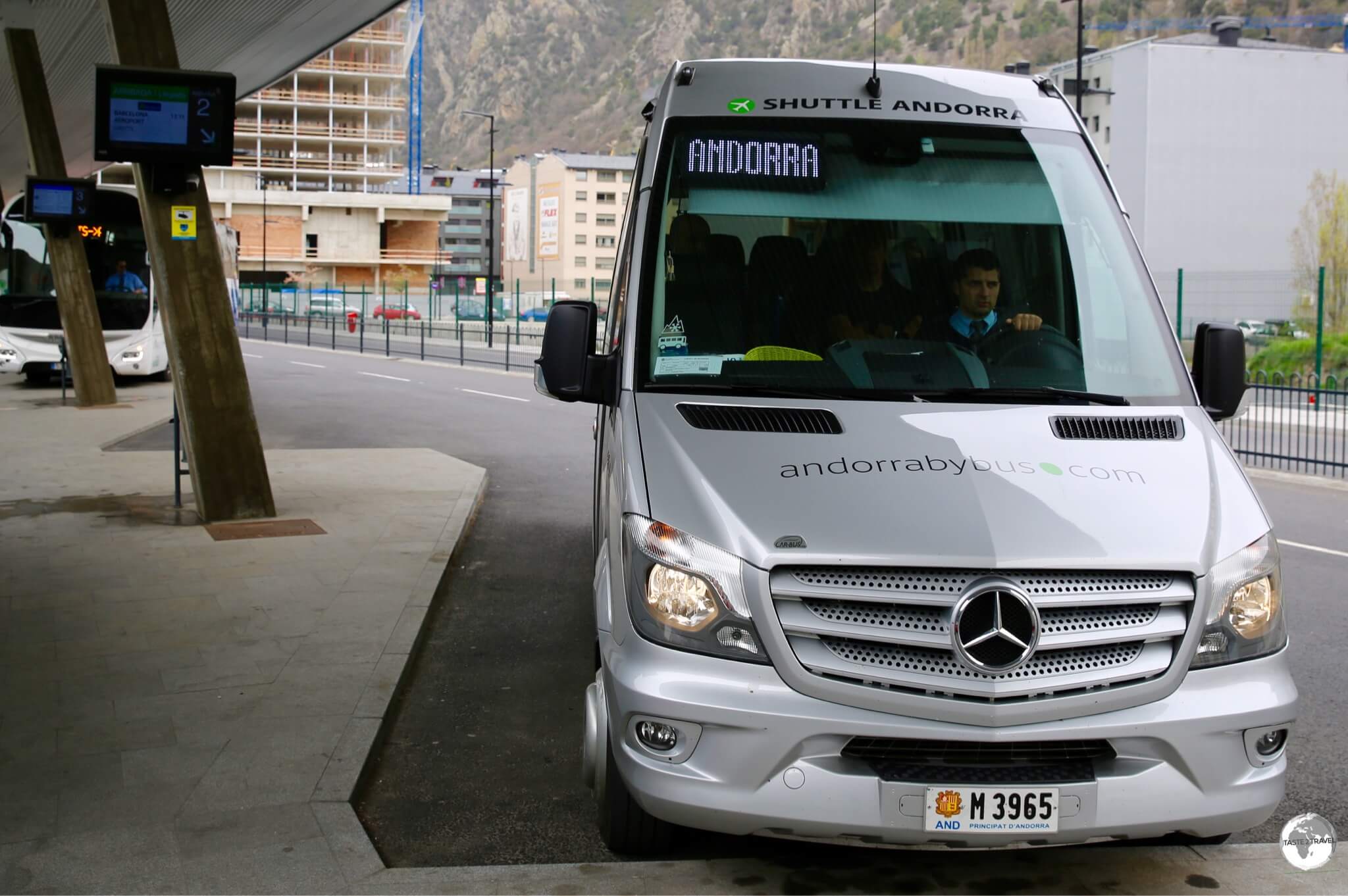
Smaller, faster minibuses also operate between Andorra and Barcelona.
Getting Around

Roads in Andorra are generally in excellent condition.
Bus
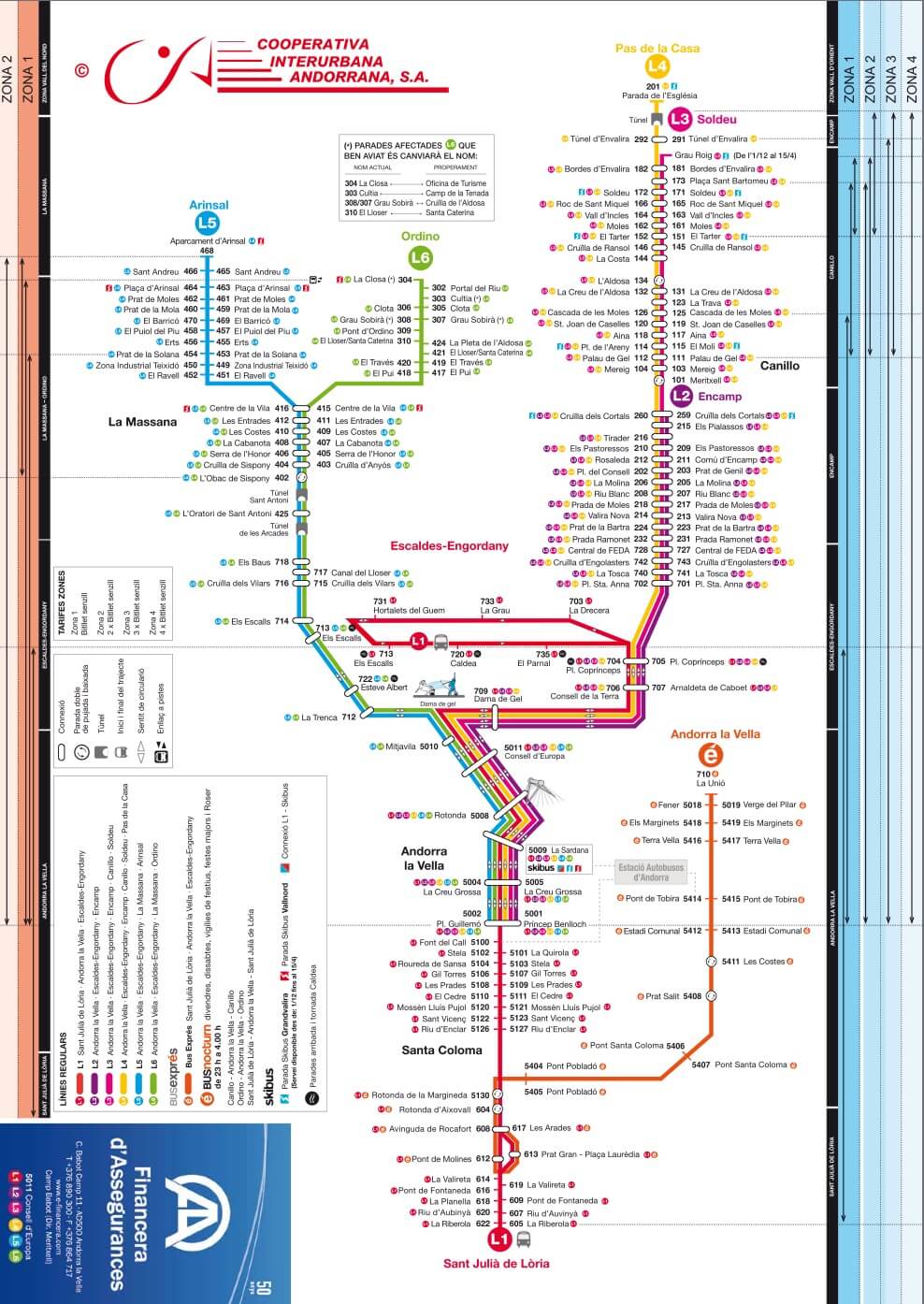
The national bus route map is available on the Interurbana website.
Public buses throughout Andorra are operated by the Cooperativa Interurbana Andorrana, providing regular connections between Andorra La Vella and the major urban centres. There are currently six routes in operation, with comprehensive route plans and timetables available from their website along with fares and details on season passes.
The company provides a handy route map (displayed above) which can downloaded, printed then folded to carry in your pocket.
Taxi
Taxis can be found on ranks in Andorra La Vella and are reasonably priced with a trip from the bus station to the old town costing about €5.
Rental Car

Exploring the Vallnord region in my rental car from Goldcar rental.
Many of the most scenic routes in Andorra are not covered by public transport. If you wish to maximise your time and fully explore this magnificent principality then hiring a rental car is the best option.

The national highway winds its way across Andorra, connecting the Principality to Spain and France.
If you’re staying in the capital, you’ll find almost no free parking, but ample municipal parking stations which charge around €28 for overnight parking. Most hotels have ‘validation’ arrangements with their nearest parking station, saving guests around 50%.

The Andorra license plate on my rental car.
If you’re driving into France or Spain, its worth noting that fuel is cheaper in Andorra (€0.20 cents per litre cheaper than France and €0.10 cents per litre cheaper than Spain) and this is evident by the number of French-registered cars filling up at the many service stations on the Andorran side of the French border.

In the distance, the ski slopes of the Vallnord resort looks like a giant white snake slivering along the side of the mountain.
For professional service and competitive rates, I would recommend using Goldcar Rental whose office is a short walk from the main bus station.
Other rental agents in Andorra La Vella include:
That’s the end of my Andorra Travel Guide.
Safe Travels!
Darren
Follow me on Instagram:
[instagram-feed feed=1]
Andorra Travel Guide Andorra Travel Guide Andorra Travel Guide Andorra Travel Guide Andorra Travel Guide Andorra Travel Guide Andorra Travel Guide Andorra Travel Guide Andorra Travel Guide Andorra Travel Guide Andorra Travel Guide Andorra Travel Guide Andorra Travel Guide
Author: Darren McLean
Darren McLean is an Australian, full-time, digital nomad who has spent 37 years on a slow meander around the globe, visiting all seven continents, 192/ 193 UN countries and 245/ 251 UN+ countries and territories.
He founded taste2travel to pique one’s curiosity and inspire wanderlust.








I liked the post… I have thought to go sightseeing again in the regions of Andorra this month! One of the things I like most about this region are the rich places for sightseeing and entertainment and besides these buildings and houses reminds me of many movies… really is a wonderful place to visit in the summer season. I’ve met some regions of this country, and actually cooking has left me with water in my mouth. The city has restaurants with very tasty menus and also has great places for family outing. Thank you for sharing your experience with us about this country.
HI Cleber,
Many thanks for your positive feedback. Andorra is a special destination, with so much to offer and I cannot wait to return next time I’m in the region.
Happy travels!
Darren
We are going to Andorra next year. Thanks for the Travel Guide!
Hi Pete,
Thanks for responding, I hope you found the guide to be useful.
Andorra is a wonderful destination.
Enjoy your time there!
Darren